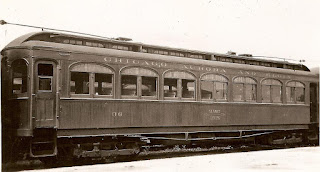Many wooden interurban cars, and even some of the earlier steel cars, were adorned with graceful arched stained glass windows on the exterior, a design feature copied from steam road passenger cars of the time. All of the wooden cars on the Chicago Aurora and Elgin had this feature when built, and that's what this article is about. On the CA&E these exterior windows were called "streamer sash"; I don't know where this term came from. But the streamer sash show up in pictures, and have been a favorite subject of CA&E fans ever since the preservation movement started.
The "shorties" as built (both Niles and Stephenson) had upper sash that appear to be one large pane of milk glass. This lasted a relatively short time, and it's easy to see why. Once the glass developed a crack, as could easily happen in regular service, the entire pane had to be replaced.
Later orders of cars were built with the leaded streamer sash. This is a picture of the 309 in the 30's, and as far as I can tell the car still had its as-built windows.
And as best as I can determine, all of the CA&E streamer sash windows were discarded; there are no original examples still in existence. I would love to be proven wrong about this, but that is what the available evidence indicates. Further information would be welcome.
(And as a side note, it is certain that all these windows were removed and replaced with wood, not just covered over as happened with the IT interurban cars, for instance, where they are still in place but covered by sheet-metal plates. This obviously makes restoration of the CA&E cars a more difficult challenge.)
And therefore all of the preserved CA&E wooden cars were acquired by the various museums without their streamer sash, of course.
Now we get into the realm of controversy. Most preservationists over the years seem to agree that removal of the arched windows was an esthetic disaster, and from the first, many have wanted to rebuild the preserved wood cars by reinstalling streamer sash. But with no original windows available, what do you do?
The most obvious solution was to acquire interior arched windows from the few cars that had them, at least those which were not being preserved. And here we can start counting windows almost precisely.
Exactly 13 CA&E cars had interior stained glass windows, cars 309 to 321 inclusive. These cars were from three different builders: two from Hicks, five from Kuhlman, six from Jewett. And the interior stained glass windows in these cars were of three different designs.
 |
| Hicks interior window |
 |
| Kuhlman interior window |
 |
| Jewett interior window |
Eight of these 13 cars went into preservation, all keeping their interior windows. The other five (310 to 314) were scrapped at Wheaton. B105 lists the 312 as being retired in 1959, so it probably was scrapped before 1962. But it appears that all the rest had their interior upper sash removed by museum people first.
The 310's windows, a complete set, were acquired by IRM. They were originally intended for installation in the 309 as exterior windows, but this never happened, of course. After the fire two of them were used to replace ones in the 309 damaged in the fire, and the rest are still in storage. Thus all of the Hicks interior windows are accounted for.
That leaves three Kuhlman cars. A complete set of Kuhlman interior windows was acquired by Rockhill, with the intention of installing them on the 315 as exterior windows, and this has now been done. Another set, more or less complete, was acquired by IRM, and some of these windows were probably acquired by individuals; about eight were still in storage by 1998. We then traded four of them to Rockhill in exchange for third-rail beams. (The four interior windows in the smoker of the 315 had been removed by the CA&E.) Another complete set was evidently acquired by Fox River, and they are now planning to install these on the 316 as exteriors. And that accounts for all of the Kuhlman interior windows.
All six Jewett cars were selected for preservation. The 316, 317, 319, and 320 still have all their interior windows intact. The 321 was acquired to be scrapped for parts, and the interior windows were removed in 1962 and either sold or distributed amongst the members; a couple of these are now in IRM's possession. When the 318 was scrapped by IRM in 1979, all of its interior windows were acquired to enable the restoration of the 321, and they are now in storage. So that accounts for everything except a few from the 321 that may still be floating around.
The problem with using interior windows on the outside is that all of the interior windows are a completely different design from the exterior streamer sash, although the Jewett interiors are somewhat closer than the other two. This is easily seen from the pictures included in this article. It changes the exterior appearance noticeably from what it was historically, and it's a matter of judgment, I suppose, how important that is to the people involved.
The only alternative is to have new streamer sash fabricated, using the available B&W photographs as a guide. This is expensive, but the results are much more historically accurate. Mount Pleasant did this when the 320 was restored to its appearance during the 20's. This particular aspect of the restoration was very well done, in my opinion.
 |
 |
So that's the current status, as far as we know. As usual, comments and questions are welcome, but please, in view of the subject matter...
don't throw stones!!!
.JPG)












No comments:
Post a Comment